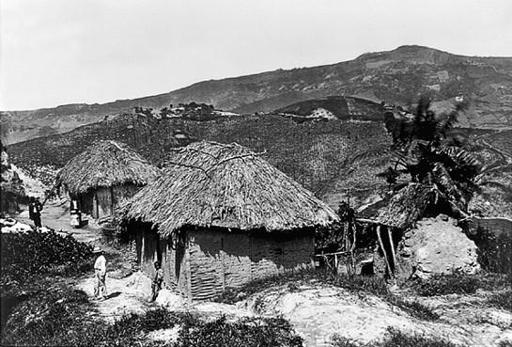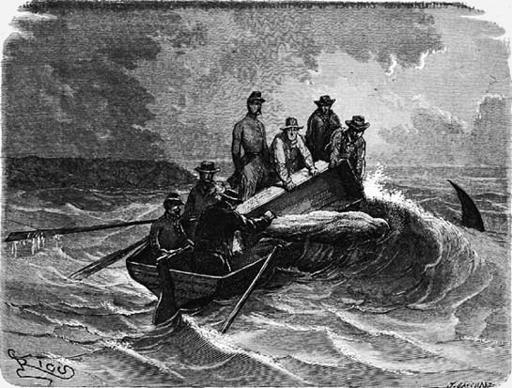1493: Uncovering the New World Columbus Created (20 page)
Read 1493: Uncovering the New World Columbus Created Online
Authors: Charles C. Mann
Tags: #Americas (North; Central; South; West Indies), #Expeditions & Discoveries, #United States, #Colonial Period (1600-1775), #History


Sugar plantations denuded Barbados, as shown in the background of this photograph of workers’ huts in the 1890s. (
Photo credit 3.5
)
Another beneficiary was
Aedes aegypti
, the yellow fever vector.
A. aegypti
likes to breed in small amounts of clear water near human beings; naval water casks are a well-known favorite. Sugar mills abounded with equivalent vessels: the crude clay pots used to crystallize sugar. Plantations had hundreds or thousands of these vessels, which were only used for part of the year and often broken. Today we know that
aegypti
likes to breed in the puddles that collect in the interior of cast-off automobile tires. Sugar pots were a seventeenth- and eighteenth-century equivalent. McNeill noted that the pots would have been full of sugary residue, fodder for the bacteria that
aegypti
larvae feed upon. Sugar plantations were like factories for producing yellow fever.
Incoming Europeans didn’t know these details. But they were entirely aware that the Caribbean was, as historian James L. A. Webb wrote in a recent history of malaria, “a lethal environment for non-immunes.”
Malaria percolated from the Caribbean into South America, and thence up the Amazon. The river has a plenitude of hosts: a 2008 survey of the Madeira River, an important Amazonian tributary, found no less than nine
Anopheles
mosquito species, all of which carried the parasite. The first Europeans to visit Amazonia described it as a thriving, salubrious place; malaria and, later, yellow fever turned many rivers into death traps. By 1782 the parasite was sabotaging expeditions into the upper reaches of the river basin. For two centuries the disease was a sometime, scattered thing: big stretches of Amazonia, depopulated by smallpox and slavery, had too few inhabitants to sustain the parasite. It may have been more common in the far western tributaries like the Madeira, because they experienced fewer Dutch and Portuguese slave raids, and thus had more people to infect. Malaria nearly killed French naturalist Alcide d’Orbigny in 1832 in the Madeira region, but a decade later another naturalist, the U.S. amateur William Henry Edwards, “encountered but one case” of it on the river, despite camping for days near its mouth.
Much worse was the northeastern bulge of South America, the region the geographer Susanna Hecht has called the Caribbean Amazon. Bounded to the south by the Amazon River in Brazil and to the west by the Orinoco River in Venezuela, it was a watery place that Arawak and Carib people controlled with sprawling networks of dikes, dams, canals, berms, and mounds. Large expanses of forest were managed for tree crops, especially the palms that in tropical places provide fruit, oil, starch, wine, fuel, and building material. Beneath the palms lay scattered patches of manioc (cassava). This landscape of gardens, orchards, and waterways served for centuries as a bridge between the interior and the islands. Such complex arrangements typically are supervised by strong, well-organized governments. Europeans certainly thought the Indians had them—it explained why their repeated efforts to seize this rich agricultural land were repelled. Only in the eighteenth century did the foreigners gain a foothold, aided by the introduction of European diseases: smallpox, tuberculosis, and influenza cleared the way for malaria. Indians retreated into the interior as Europeans seized the coast, creating sugar plantations in what eventually became, after much international squabbling, Guyane (French Guiana), Suriname (formerly Dutch Guiana), and Guyana (formerly British Guiana).
Archetypical may have been Guyane, which was formally acquired by France in a treaty in 1763. Initial colonization efforts proved so disastrous that the nation almost forgot its existence until three decades later, when a military-backed coup overthrew the parliament established by the French Revolution. The new dictatorship piled 328 unwanted deputies, clergymen, and journalists into small vessels and dumped them in the colony.
P. falciparum
greeted them on the shore. Within two years more than half were dead, either killed by malaria or sufficiently weakened by it to be slain by other ailments. Undeterred, the French state kept sending over criminals and undesirables. French prisoners had in the past served as galley slaves on special prison ships in the Mediterranean. After the steam engine made galleys obsolete convicts were dispatched to Guyane. Violent offenders ended up in the infamous prison on Devils Island, seven miles off the coast; the rest joined chain gangs of agricultural labor. Disease claimed so many that Guyane became known as a “dry guillotine”—a blade that killed without needing to wet itself with blood. Perhaps eighty thousand Frenchmen made the passage. Very, very few returned.
Unable to settle in disease zones, Europeans never established communities there. The ideal was offshore ownership. Europeans would remain in the safety of the home country while small numbers of onsite managers directed the enslaved workforce. Because captives would outnumber captors, intimidation and brutality would be necessary to keep the sugar mills grinding. In the realm of falciparum and yellow fever, sugar despotism became the rule: tiny bands of Europeans atop masses of transplanted Africans, angry or demoralized or stoic according to their characters.
Nothing is wrong with offshore ownership per se. If French wine makers buy wineries in California or U.S. wine makers buy wineries in Bordeaux or Burgundy, the acquisitions may sting local pride but are unlikely to have any larger effect on either nation. It is different if foreign wine makers buy
every
winery—or, stronger yet, if people thousands of miles away dominate
every
industry. One all-too-representative example: a single Liverpool firm, Booker Brothers, controlled three-quarters of British Guiana’s economy for almost a century. All the profits ended up on the other side of the ocean. So did all of the entrepreneurial, managerial, and technical expertise. Locals provided only labor. Indeed, they were punished if they tried to do anything else.

The French artist Édouard Riou, now best known for his illustrations of Jules Verne, traveled to France’s colony of Guyane in 1862–63. A visit to the prison islands produced this image of the sea burial of a convict, presumably a victim of malaria or yellow fever. (
Photo credit 3.4
)
As the economists Acemoglu, Johnson, and Robinson noted, distant and disconnected owners had little interest in building the institutions necessary to maintain complex societies: schools, highways, sewers, hospitals, parliaments, legal codes, agricultural-extension agencies, and other governmental systems. In places with a full array of functioning institutions, locals can compete economically with foreigners by developing new technologies and new business methods. In extractive states, locals never got the chance. Most of the English colonists who went to Virginia or Australia were servants or convicts, the lowest tiers in the social pyramid. But despite their bottom ranking their status as citizens gave them some ability to use the institutions of the homeland to push back when their leaders tried to oppress them. (Australia’s convicts, for example, began winning lawsuits against their would-be abusers almost as soon as they landed.) The slaves in extractive states had no such ability to tap into these institutions. Indeed, elites actively sought to cut off their access. A particular worry was education; echoing many in British Guiana, Booker president Josiah Booker denounced the notion of teaching his company’s employees to read because it would encourage them to aspire “far above their station in life.” Wrong ideas in the wrong people’s hands could put the elites’ political power at risk.
History suggests, Acemoglu, Johnson, and Robinson wrote, that industrialization cannot occur without “both investments from a large number of people who were not previously part of the ruling elite and the emergence of new entrepreneurs.” Both are next to impossible in extractive states. Over the decades, reformers tried to counteract the system’s effects. Missionaries provided education for Guyana’s children; the British Anti-Slavery Society thundered unceasingly against mistreatment, launched investigations, and provided aid. “Jock” Campbell, the visionary head of Booker Brothers’ corporate successor, spent decades improving sugar workers’ conditions. The reformers did everything but change the basic extractive system. When Guyana gained formal independence in 1966, 80 percent of its export earnings were controlled by three foreign companies, one of them Campbell’s. The new nation had just one university, a night school established three years before.
WAR AND MOSQUITOES
In malaria zones, the primary victims are children. Adults as a rule have already had the disease and become immune upon survival. The adults who have most to fear are recent arrivals—a lesson that was learned in the Americas again and again, perhaps most dramatically during the U.S. Civil War. Much of the war was fought in the South by troops from the North. Crossing the Mason-Dixon Line, Yankees broke an epidemiological barrier. The effects were enormous.
In July 1861, three months after the conflict began, the Union’s Army of the Potomac marched from Washington to the Confederate capital of Richmond, Virginia. It was repulsed at what became known to Yankees as the Battle of Bull Run and to Confederates as the Battle of Manassas. After fleeing to Washington, the generals dragged their feet about further action. President Lincoln railed against their pusillanimity, but they may have had a point. In the year after Bull Run, more than a third of the Army of the Potomac suffered from what army statistics describe as remittent fever, quotidian intermittent fever, tertian intermittent fever, quartan intermittent fever, or congestive intermittent fever—terms generally taken today to mean malaria. Union troops in North Carolina fared still worse. An expeditionary force of fifteen thousand landed at Roanoke Island in early 1862, and spent much of the war enforcing a naval blockade from a fort on the coastline. The air at dusk shimmered with
Anopheles quadrimaculatus
. Between the summer of 1863 and the summer of 1864, the official annual infection rate for intermittent fevers was
233 percent
—the average soldier was felled two times or more.
From the beginning the Union army was bigger and better supplied than the Confederate army. As at Bull Run, though, the North lost battle after battle. Incompetent generalship, valiant opponents, and long supply lines were partly to blame. But so was malaria—the price of entering the
Plasmodium
zone. During the war the annual case rate never dropped below 40 percent. In one year
Plasmodium
infected 361,968 troops. The parasite killed few directly, but it so badly weakened them that they succumbed readily to dysentery or measles or what military doctors then called “chronic rheumatism” (probably a strep infection). At least 600,000 soldiers died in the Civil War, the most deadly conflict in U.S. history. Most of those lives were not lost in battle. Disease killed twice as many Union troops as Confederate bullets or shells.
Malaria affected the course of the war itself. Sick soldiers had to be carried in litters or shipped out at considerable cost. With so many sick for so long the resource drain was constant. Confederate generals did not control malaria or even know what it was, but it was an extra arrow in their quiver.
Plasmodium
likely delayed the Union victory by months or even years.
In the long run this may be worth celebrating. Initially the North proclaimed that its goal was to preserve the nation, not free slaves; with few dissenting votes, Congress promised rebel states that “this war is not waged” for the “purpose of overthrowing or interfering with [their] rights or established institutions,” where “established institutions” was taken to mean slavery. The longer the war ground on, the more willing grew Washington to consider radical measures. Should part of the credit for the Emancipation Proclamation be assigned to malaria? The idea is not impossible.